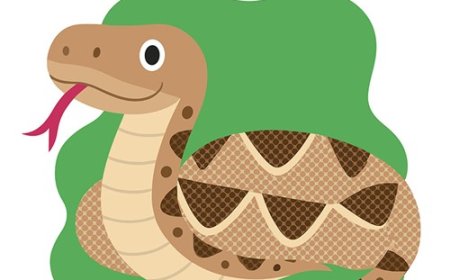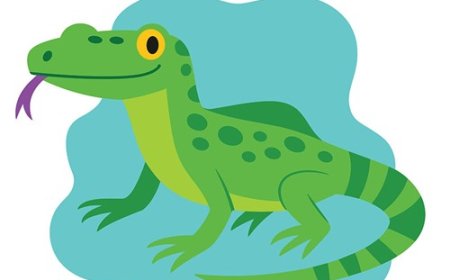Anole Lizard Facts for Kids – Small Reptiles with Big Color
Explore the anole lizard, a small reptile known for changing from green to brown and its throat fan display

Anole Lizard Facts for Kids - Small Reptiles with Big Color
Scientific Name and Classification
-
Common Name: Anole Lizard (Green Anole)
-
Scientific Name: Anolis carolinensis (for the green anole; other species vary)
-
Kingdom: Animalia
-
Phylum: Chordata
-
Class: Reptilia
-
Order: Squamata
-
Family: Dactyloidae
-
Genus: Anolis
-
Species: A. carolinensis
🐍 Introduction
The anole lizard is a small, active reptile found in warm parts of North America, Central America, and the Caribbean. The green anole, one of the most common species, is often called the "American chameleon" because it can change color from green to brown.Anoles are known for their quick movements, climbing skills, and the colorful dewlap (throat fan) that males use for communication.
🦎 Appearance
Anoles are small lizards, usually 5-8 inches (12-20 cm) long, with slender bodies, long tails, and smooth scales. The green anole can shift from bright green to brown depending on temperature, mood, and environment.Males have a brightly colored dewlap, often pink or red, which they extend during displays. Females may have a smaller dewlap and sometimes a light stripe along their back.
🌍 Habitat
Anoles live in forests, gardens, parks, and urban areas with plenty of plants and places to climb. They are often found on trees, fences, and walls where they can hunt for insects and bask in the sun.The green anole's range includes the southeastern United States, while other anole species live in Central and South America and on Caribbean islands.
🍽 Diet
Anoles are insectivores, feeding on flies, crickets, moths, beetles, and other small insects. They actively hunt during the day, using quick bursts of speed to catch their prey.
🔄 Life Cycle
Female anoles lay single eggs, usually every one to two weeks during the breeding season. The eggs are buried in soil or leaf litter and hatch after about 5-7 weeks.Young anoles are independent from birth and grow quickly, reaching maturity within a year. Most live 2-5 years in the wild, and longer in captivity.
🐾 Behavior and Social Structure
Anoles are diurnal (active during the day) and highly territorial. Males defend their space by displaying their dewlap, bobbing their heads, and doing push-ups to warn rivals.They are excellent climbers, using specialized toe pads to grip smooth surfaces.
🛡 Conservation Status
-
IUCN Red List: Least Concern (LC) for green anole; varies for other species.
-
Main Threats: Habitat loss, competition from invasive species like the brown anole.
-
Conservation Efforts: Habitat protection and invasive species control in some areas.
🎭 Cultural Significance
In parts of the southeastern United States, the green anole is a familiar backyard reptile and is sometimes kept as a pet. Its color-changing ability has made it a popular subject in children's books and nature programs.
✨ Fun Facts
-
Can change color between green and brown.
-
Males have a colorful throat fan called a dewlap.
-
Can drop their tails to escape predators.
-
Use toe pads to climb smooth surfaces.
📌 Key Takeaways
-
Small, color-changing lizard found in the Americas.
-
Males display colorful dewlaps to attract mates and defend territory.
-
Insect-eating reptile active during the day.
-
Excellent climber with specialized toe pads.
-
Conservation status is mostly stable.
🐾 Kid-Friendly Summary
The anole is a small lizard that can change color and climb walls with ease. Males have a colorful throat fan they use to show off or warn other lizards. Anoles are quick hunters that help control insect populations in their habitats.
📚 Vocabulary Words
-
Insectivore - An animal that eats mostly insects.
-
Dewlap - A flap of skin under the throat used for display.
-
Diurnal - Active during the day.
-
Territorial - Protective of a specific area or home.
-
Camouflage - Colors or patterns that help animals hide.
-
Leaf litter - Dead leaves on the ground that create habitat for small animals.
-
Push-up display - A movement used by some reptiles to show dominance.
-
Specialized - Designed or adapted for a specific purpose.
🧠 Interactive Quiz
-
What do monitor lizards use their forked tongues for?
A. Eating
B. Smelling
C. Drinking
D. Cooling off
-
True or False: All monitor lizards live in dry deserts.
-
What type of food do monitor lizards eat?
A. Only plants
B. Only fish
C. Meat and a variety of prey
D. Only insects
-
Where might a water monitor spend most of its time?
A. In caves
B. In the ocean
C. Near rivers and lakes
D. In tree tops
-
What is a group of eggs called?
A. Nest
B. Clutch
C. Colony
D. Pack



















































